INTRODUCTION
This chapter looks at the sources of water used by Australian households. The majority of households have mains/town water supply, but other households relied on rainwater tanks, bores or wells and water from rivers, creeks and dams. Some households supplement their water supply by collecting water (in containers other than tanks) or by using grey water.
2.1 Sources of water for households: 2007
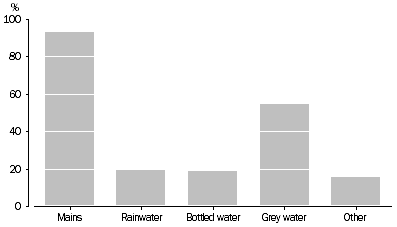
MAINS OR TOWN WATER
Mains water is the most common source of water for Australian households. In March 2007, 93.4% of Australian households (7,534,400) reported sourcing their water from the mains/town water supplies. More households within capital cities were connected to mains/town water (98.5%), compared with 84.6% outside the capital cities.
The number of Australian households that have sourced their water from the mains/town supply has remained steady since 1994, with close to 93% of households reporting mains/town as a source of water (table 2.12). The Australian Capital Territory is the only state or territory where all households reported mains/town water as a source of water.
The main source of water used for gardening by 42.1% of Australian households was mains/town water (table 2.13 and graph 2.2). The Northern Territory (72.5%) had the greatest proportion of households reporting mains/town water as their main source of water for the garden, followed by South Australia and Western Australia (66.6% and 66.1% respectively). Only one quarter (26%) of households in Queensland reported mains/town water as their main source of water for the garden. This was the lowest proportion of all states and territories. Victoria had the second lowest proportion with 31.3% of households.
2.2 Mains or town water as main source of water for gardening: 2007

In Queensland, Western Australia and New South Wales in particular, the proportion of households outside the capital cities reporting mains/town water as their main source of water in the garden was greater than within the capital cities. In the other states, the proportion of households reporting mains/town water as their main source of water for gardening was greater in the capital cities than in the rest of the state.
Australian households reported that mains/town water was their main source of water for: bathing and showering (92.4%), for washing clothes (89.1%) and for flushing the toilet (92.0%) (tables 2.14, 2.15 and 2.16. and graph 2.3). The Australian Capital Territory had the greatest proportion of households reporting mains/town water as the main source for bathing and showering (100%), washing clothes (98.7%) and for flushing the toilet (99.7%). Tasmanian households had the lowest proportion of households reporting mains/town water as their main source for these activities (83.8%, 82.3%, and 83.2% respectively).
2.3 Mains water as a source of water for washing clothes, showering or flushing toilet: 2007

Almost eighty-one per cent (80.8%) of Australian households reported that the mains/town water was their main source of water for drinking (table 2.17). The Australian Capital Territory had the greatest proportion of households (95%) whose main source of drinking water was the mains/town water. The state with the lowest proportion was South Australia (63.7%). This was consistently the lowest for both Adelaide (74.5%) and the rest of state (33.3%).
Nine out of ten households (89.4%) in capital cities reported mains/town water as their main source of water for drinking, compared with 65.7% outside the capital cities. Given that 84.6% of households outside the capital cities reported mains/town water as a source of water, (table 2.11), this means that 18.9% of households are choosing other sources of water, such as bottled water, as their main source of water for drinking, despite being connected to mains/town water.
2.4 Mains or town water as a source of drinking water: 2007

PROBLEMS AND SATISFACTION WITH THE MAINS WATER SUPPLY
Of households that reported mains/town water as a source of water in 2007, 77.2% were satisfied with its quality, 18.5% were not satisfied and 3.5% did not drink the mains water (table 2.20). Furthermore, 28.6% used a water filter in 2007 (table 2.19). Use of filters has been steadily rising since 1998 when 18.2% of households used water filters. South Australia had the highest rate (38.4%) of filter use, whereas the Northern Territory (14.1%) and the Australian Capital Territory (14.8%) had the lowest reported use of water filters. These two territories have consistently reported the lowest use of water filters since 1998.
With households in the Australian Capital Territory and the Northern Territory reporting the lowest use of water filters (table 2.19), it is not unexpected that households in these two territories reported a high percentage of satisfaction with the quality of mains/town water (table 2.20). Almost 88% of households in the Australian Capital Territory (87.8%) and in the Northern Territory (87.0%) were satisfied with the quality of water from the mains.
The proportion of households in capital cities that were satisfied with the quality of the mains water (80.7%) was greater than households outside of the capital cities (70.1%).
Households from South Australia had the largest proportion (8.7%) reporting they did not drink the mains water, and the highest proportion reporting that they were not satisfied with the quality of mains water (25.8%).
Of households that were not satisfied with the quality of water and those who did not drink the mains water (table 2.21), the main reason was taste with 51.7%, followed by the presence of chlorine in the mains water (25.8%).
Tasmania had the highest proportion of household reporting odour, colour and chlorine as problems with the quality of mains/town water. Microbial contamination in New South Wales was the cause of dissatisfaction for 13.2% of households, a greater proportion than in any other states or territory.
The majority (84.9%) of households that reported mains/town water as a source of water reported no water supply problems in the 12 months to March 2007 (table 2.22). Seven per cent of households reported inadequate or low pressure and 5.7% of households reported supply disruptions.
GREY WATER
Grey water is water reused from waste water sourced from shower/bath, laundry and kitchen. It is the second most common source of water for households after mains/town water (54.5%). Victoria had the highest percentage of households reporting grey water as a source (71.7%), followed by the Australian Capital Territory (63.1%) (table 2.11.). The Northern Territory had the lowest reported use of grey water (32.2%).
Using grey water was more common outside the capital cities than within them in every state except Queensland. In Queensland, 63.2% of households in Brisbane reported grey water as a source of water but in the balance of state, only 46.4% of households reported grey water as a source.
2.5 Households reporting grey water as a source of water: 2007
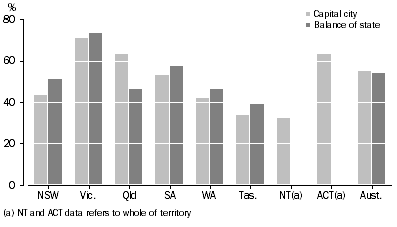
Almost one quarter (24.0%) of Australian households reported grey water as the main source of water for the garden (table 2.13).
In Victoria and Queensland grey water was the most common source of water for the garden (42.7% and 27.2% respectively). The Australian Capital Territory (20.5%) and New South Wales (19%) also had high proportions that reported grey water as the main source of water in the garden. The Northern Territory (3.5%) and Western Australia (4.5%) had the lowest proportion of households reporting grey water as their main source of water for the garden (graph 2.6).
2.6 Grey water as the main source of water for the garden(a): 2007
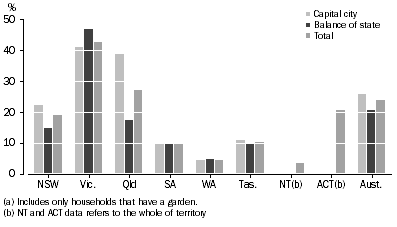
Grey water can also be used to flush the toilet (table 2.16), although relatively few households used grey water as a main source for this purpose (0.5%). Victoria had the greatest proportion of households reporting grey water as their main source of water for flushing the toilet (1.1% or 20,900).
RAINWATER TANKS
In March 2007, 19.3% of Australian households reported sourcing water from rainwater tanks (table 2.11 and graph 2.7). South Australia had the largest proportion (45.4%) of households that reported a rainwater tank as a source of water. This figure increased to 69.2% of households outside of Adelaide. Queensland had the second highest proportion (22.1%).
In capital cities only one in ten households (11.2%) reported sourcing of water from a rainwater tank, compared with one-third of households (33.5%) outside the capital cities.
2.7 Households sourcing water from a rainwater tank: 2007
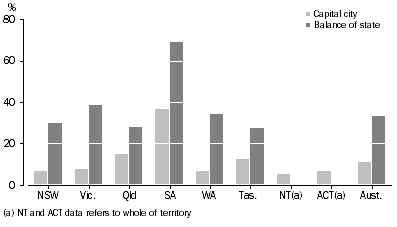
Nationally, households reporting rainwater tanks as a source of water have increased from 15.2% in 1994 to 19.3% in 2007 (table 2.12 and graph 2.8). In Queensland the number of households sourcing water from tanks increased from 17.4% in 2004 to 22.1% in 2007. The Australian Capital Territory rainwater tanks as a source of water more than doubled from 3.2% in 2004 to 6.7% in 2007.
However, in South Australia the proportion of households sourcing water from a rainwater tank has been falling since 1998 (53.5%) to 45.4% in 2007. South Australia, nevertheless, has consistently had the highest proportion of households sourcing water from a water tank since 1994.
2.8 Rainwater tanks as a source of water: 1994 to 2007

Over five per cent (5.5%) of Australian households used rainwater as their main source of water for the garden (table 2.13). South Australia and Queensland had the highest proportion of households reporting rainwater tanks as the main source of water for their garden (8.3% and 7.1% respectively).
Nationally 6.0% of households reported that their main source of water for showering and bathing was the rainwater tank (table 2.14), and 5.9% reported rainwater tank as their main source for washing clothes (table 2.15). Over four per cent (4.5%) reported it as their main source of water for flushing the toilet (table 2.16).
Tasmania had the highest proportion of households that reported rainwater tanks as their main source of water for showering or bathing (12.1%), washing clothes (12.1%) and for flushing the toilet (10.3%). Queensland had the second greatest proportion of households reporting rainwater tank as main source of water for showering or bathing (8.7%) and flushing the toilet (7.4%). South Australia has the second greatest proportion of households reporting rainwater as the main source of water for washing clothes with 8.6% (graph 2.9).
2.9 Rainwater tank as source of water for showering, washing clothes and flushing toilet - 2007

Rainwater tanks were the main source of drinking water for 10.1% of Australian households in 2007. South Australia had the highest proportion (22.0%) of households whose main source of drinking water was a rainwater tank, followed by Tasmania with 14.9%.
Outside capital cities, a greater proportion of households (23.3%) reported that their main source of water for drinking was a rainwater tank compared with only 2.5% within the capital cities. One in ten households in Adelaide (10.6%) reported a rainwater tank as their main source of drinking water, the highest proportion of any captial city in Australia. South Australia also had the greatest proportion of households outside the capital cities (54.2%) whose main source of drinking water was a rainwater tank. This was more than double the next highest proportion in Western Australia (26.6%).
PURCHASED BOTTLED WATER
Purchased bottled water was reported as a source of water by 18.6% of households (table 2.11). South Australia and Western Australia had the highest proportions, 22.0% and 21.6% respectively. Except for Queensland and South Australia, households outside of the capital cities were more likely to purchase bottled water than households within capital cities.
The proportion of households reporting purchased bottled water as a source had been increasing steadily between 1994 and 2004. In 2007, it had fallen to 18.6% of households, down from 20.6% in 2004 (table 2.12 and graph 2.10). The largest decrease was in the Australian Capital Territory which fell from 25.9% in 2004 to 15.1% in 2007, followed by New South Wales, down from 24.8% to 18.5%. In South Australia, the reporting of purchased bottled water as a source has remained steady at 22.0% since 2004 while it has increased slightly in Western Australia and Tasmania.
2.10 Purchased Bottled Water: 1994 to 2007
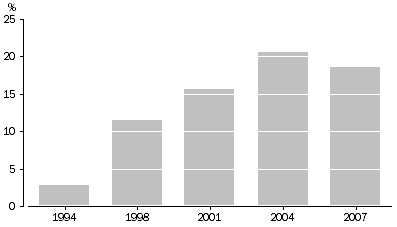
OTHER SOURCES OF WATER
Almost six per cent (5.9%) of Australian households reported that they sourced water from a bore or well (table 2.11). The proportions were relatively low in all states and territories, except for Western Australia where 22.8% of households reported a bore or well as a source of water. In Western Australia, one-quarter (25.1%) of households in Perth reported a bore or well as a source of water. Outside of Perth, 15.8% of households reported that they sourced water from a bore or well.
In Western Australia, 22.8% of households with a garden used bore or well water as their main source of water for the garden, compared to 5.3% nationwide (table 2.13).
Australian households have been collecting rainwater in containers (other than rainwater tanks) as a source of water, with 5.7% of households reporting this activity. This involved households placing buckets, bins or other containers under downpipes or simply leaving containers out in the rain. This activity was more common in the eastern states and territory of Victoria (7.9%), New South Wales (6.5%), and Queensland (5.2%).
 Print Page
Print Page
 Print All
Print All